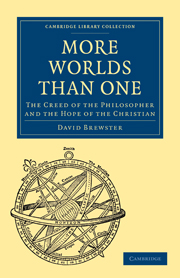Book contents
- Frontmatter
- Contents
- PREFACE
- INTRODUCTION
- CHAP. I Religious Aspect of the Question
- CHAP. II Description of the Solar System
- CHAP. III The Geological Condition of the Earth
- CHAP. IV Analogy between the Earth and the other Planets
- CHAP. V The Sun, Moon, Satellites, and Asteroids
- CHAP. VI The Motion of the Solar System round a distant Centre
- CHAP. VII Religious Difficulties
- CHAP. VIII Single Stars and Binary Systems
- CHAP. IX Clusters of Stars and Nebulæ
- CHAP. X General Summary
- CHAP. XI Reply to Objections drawn from Geology
- CHAP. XII Objections from the Nature of Nebulæ
- CHAP. XIII Objections from the Nature of the Fixed Stars and Binary Systems
- CHAP. XIV Objections from the Nature of the Planets
- CHAP. XV The Future of the Universe
CHAP. IX - Clusters of Stars and Nebulæ
Published online by Cambridge University Press: 29 August 2010
- Frontmatter
- Contents
- PREFACE
- INTRODUCTION
- CHAP. I Religious Aspect of the Question
- CHAP. II Description of the Solar System
- CHAP. III The Geological Condition of the Earth
- CHAP. IV Analogy between the Earth and the other Planets
- CHAP. V The Sun, Moon, Satellites, and Asteroids
- CHAP. VI The Motion of the Solar System round a distant Centre
- CHAP. VII Religious Difficulties
- CHAP. VIII Single Stars and Binary Systems
- CHAP. IX Clusters of Stars and Nebulæ
- CHAP. X General Summary
- CHAP. XI Reply to Objections drawn from Geology
- CHAP. XII Objections from the Nature of Nebulæ
- CHAP. XIII Objections from the Nature of the Fixed Stars and Binary Systems
- CHAP. XIV Objections from the Nature of the Planets
- CHAP. XV The Future of the Universe
Summary
Among the bodies of the sidereal universe, astronomers have from the earliest ages recognised the existence of clusters of stars and of nebulœ. The Milky Way indicates by its name that it is of a nebular character; but a nebula, properly so called, is a limited space of light, of various forms and various degrees of brightness in its different parts. Sir William Herschel was the first astronomer who observed this class of phenomena systematically, and who divided the bodies which compose it into six classes, namely,
Clusters of stars, in which each star is distinctly seen.
Resolvable Nebulœ, or such as excite a suspicion that they consist of stars, and which a higher magnifying power may be expected to resolve into separate stars.
Nebulœ properly so called, in which there is no appearance whatever of stars.
It is very obvious that the language used in the above classification, is intended to support the theory that there is such a thing in the sidereal space as real nebulous matter, or star dust, as it has been almost jocularly called, contradistinguished from a nebulous mass of identically the same appearance which the telescope has resolved into separate stars. The phrases which we have put in italics are certainly incorrect, because any appearance, or any expectation of a nebula not being resolvable, is proved to have been erroneous the moment it is resolved.
- Type
- Chapter
- Information
- More Worlds Than OneThe Creed of the Philosopher and the Hope of the Christian, pp. 167 - 177Publisher: Cambridge University PressPrint publication year: 2009First published in: 1854



